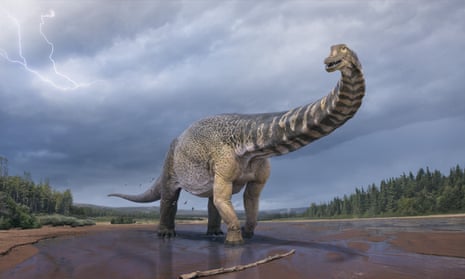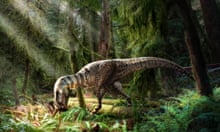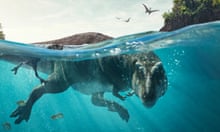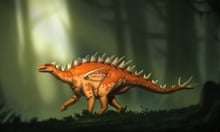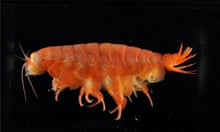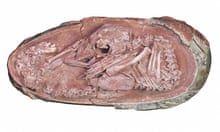A new species of dinosaur discovered in south-west Queensland has been officially recognised as the largest ever found in Australia and among the biggest in the world.
The Australotitan cooperensis, a plant-eating dinosaur of the family known as titanosaurs, likely lived between 92m and 96m years ago, during the Cretaceous period.
It was between 25m and 30m long, stood between 5m and 6.5m from the ground to its hip and had a very long neck and tail, making it similar in appearance to well-known dinosaurs such as Brachiosaurus and Apatosaurus.
Nicknamed Cooper, the Australian dinosaur was first uncovered near Cooper Creek in the Eromanga Basin in 2007, but has only now been described scientifically by Queensland Museum and Eromanga Natural History Museum paleontologists.
They found the dinosaur’s shoulder blades, limb, and pelvic bones, many of them largely intact. The remote location, size and fragility of the dinosaur bones contributed to a delay in officially determining that the remains belonged to a previously unknown species, said Robyn Mackenzie, a field paleontologist.
“Such big, fragile bones literally took years to prepare and clean,” she said.
Mackenzie co-founded the Eromanga Natural History Museum with her husband, Stuart, after dinosaur bones were first discovered on their family property in 2006. The remains of about 15 dinosaurs have since been found on the property, she said.
She said based on the lengths and circumferences of Cooper’s limbs the dinosaur would have weighed about 67 tonnes, although figures can vary widely depending on the method of estimation used.
A second Australotitan specimen has also been discovered at Eromanga. George, as it has been nicknamed, was significantly larger than Cooper: the estimated length of its femur was 2.2m, compared with Cooper’s at 1.9m. However, George’s bones were more fragmented, making them more difficult to study.
The world’s largest known titanosaur is Patagotitan, found in South America. Analysis showed Australotitan was closely related to three other Australian sauropods, a group of dinosaurs that includes the titanosaurs. The three other species were found further north, in Winton.
Dr Scott Hocknull, a palaeontologist at the Queensland Museum, said it was possible the four species evolved from each other, and into different habitats.
“At the time the dinosaurs were moving around in this Eromanga area, it was the last of the great inland sea,” which had covered parts of Australia for tens of millions of years,” he said.
“New land was being developed. The expectation that dinosaurs would fill up this land would also mean that different habitats would evolve.”
The palaeontologists noticed crush marks on some of Cooper’s bones, suggesting after its death it had been trampled by other sauropods.
“We came across a trample zone, which is basically trampled mud that has solidified and hardened into a rock shelf,” said Hocknull. The finding indicated the area was either a walkway for dinosaurs, or more likely the edge of a billabong where dinosaurs came to drink – similar to a modern waterhole, he said.
“We know that they were actually wandering in the environment,” said Hocknull. “It wasn’t just the bones getting washed in and preserved in mud.”
The researchers estimated the age of the dinosaur based on geological dating of surrounding sediments, as well as by studying the depth of where it was fossilised in the Winton Formation. The rock formation covers large swathes of central-western Queensland and is more than 1km thick in some areas.
Earlier this month, a dig on the Eromanga property uncovered dozens of new bones from another dinosaur, and investigations are under way to determine whether they belong to a new species.
